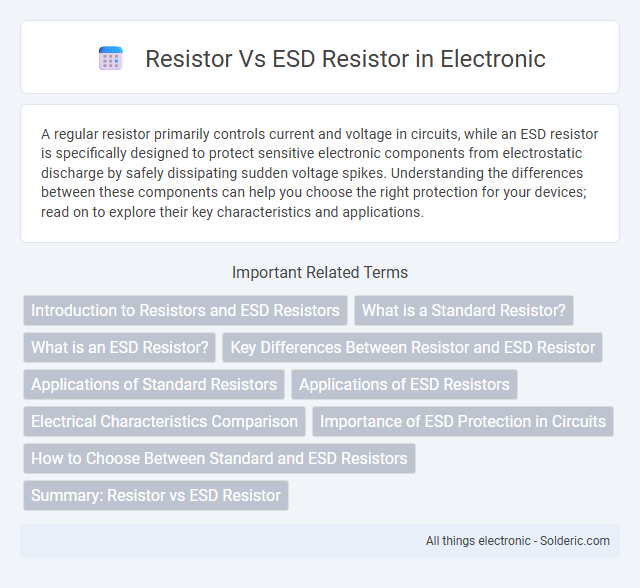A regular resistor primarily controls current and voltage in circuits, while an ESD resistor is specifically designed to protect sensitive electronic components from electrostatic discharge by safely dissipating sudden voltage spikes. Understanding the differences between these components can help you choose the right protection for your devices; read on to explore their key characteristics and applications.
Comparison Table
| Feature | Resistor | ESD Resistor |
|---|---|---|
| Function | Limits electric current in a circuit | Limits current and protects circuits from electrostatic discharge (ESD) |
| Design | Standard resistive material | Incorporates ESD protection elements or high surge tolerance |
| Resistance Range | Ohms to megaohms, based on application | Typically in kiloohms, optimized for ESD handling |
| Application | General passive electronic circuits | ESD-sensitive circuits such as communication and data lines |
| Surge Handling | Limited surge tolerance | High surge tolerance for ESD events |
| Typical Package | Standard resistor packages (SMD, axial) | ESD-protected package with enhanced robustness |
Introduction to Resistors and ESD Resistors
Resistors regulate electrical current by providing a specific resistance value, ensuring circuit stability and performance. ESD resistors, designed to protect sensitive components from electrostatic discharge, feature specialized construction to safely dissipate high-voltage spikes. These ESD resistors combine resistance with transient voltage suppression, making them essential in safeguarding electronic devices against sudden electrostatic events.
What is a Standard Resistor?
A standard resistor is an electronic component designed to provide a precise amount of electrical resistance within a circuit, ensuring controlled current flow and voltage levels. Unlike ESD resistors, which include built-in protection against electrostatic discharge to safeguard sensitive components, standard resistors primarily serve to set operating points and divide voltages. Your circuit's performance relies on selecting resistors with appropriate power ratings, tolerance, and resistance values to maintain stability and efficiency.
What is an ESD Resistor?
An ESD resistor is a specialized resistor designed to protect electronic circuits from electrostatic discharge by limiting the current flow during sudden voltage spikes. Unlike standard resistors, ESD resistors combine resistance with protective features to prevent damage to sensitive components in devices like smartphones and computers. Your circuits benefit from enhanced durability and reliability when incorporating ESD resistors in critical protection pathways.
Key Differences Between Resistor and ESD Resistor
Resistors primarily regulate electrical current by providing a specific resistance value, while ESD resistors are designed to protect sensitive electronic components from electrostatic discharge by quickly dissipating static charges. ESD resistors feature a higher resistance and power rating tailored for surge protection, compared to standard resistors that emphasize precision and stability in voltage control. Understanding these key differences ensures you select the appropriate component to safeguard your circuits against damaging ESD events.
Applications of Standard Resistors
Standard resistors are widely used in electronic circuits to control current flow, divide voltages, and set bias points in devices such as amplifiers, filters, and power supplies. These resistors find applications in consumer electronics, automotive systems, and industrial machinery where stable resistance values are crucial for circuit performance. Unlike ESD resistors designed specifically for electrostatic discharge protection, standard resistors provide general-purpose resistance for signal processing and circuit stability.
Applications of ESD Resistors
ESD resistors are commonly used in sensitive electronic circuits to protect components from electrostatic discharge by dissipating high-voltage spikes safely. They are crucial in applications such as semiconductor devices, communication systems, and consumer electronics where preventing damage from static electricity is essential. Unlike standard resistors, ESD resistors combine resistance with the ability to withstand sudden voltage surges, enhancing device reliability and longevity.
Electrical Characteristics Comparison
ESD resistors are specifically designed to handle electrostatic discharge events, featuring higher voltage ratings and faster transient response times compared to standard resistors. Standard resistors primarily regulate current and voltage within circuits under normal operating conditions, with lower surge tolerance and limited protection against voltage spikes. Your choice between them should consider the need for ESD protection and the specific electrical stress expected in your application.
Importance of ESD Protection in Circuits
ESD resistors play a crucial role in safeguarding circuits against electrostatic discharge by limiting current spikes that can damage sensitive components. Unlike standard resistors, ESD resistors are specifically designed to handle sudden high-voltage pulses, ensuring the longevity and reliability of your electronic devices. Incorporating ESD protection is essential to prevent costly failures and maintain optimal circuit performance in environments prone to static electricity.
How to Choose Between Standard and ESD Resistors
Choosing between standard resistors and ESD resistors depends on the application's susceptibility to electrostatic discharge and required protection level. ESD resistors are designed with built-in protection features to safely dissipate high-voltage static electricity without damaging sensitive electronic components, making them essential in high-risk environments. Standard resistors offer basic current control but lack the intrinsic protective elements needed to prevent ESD-related failures in sensitive circuits.
Summary: Resistor vs ESD Resistor
Standard resistors regulate current flow in electronic circuits by providing fixed resistance values, enhancing circuit stability and performance. ESD resistors incorporate specialized materials and structures designed to protect sensitive components from electrostatic discharge by safely dissipating high-voltage surges. These resistors are crucial in preventing damage in environments prone to static electricity, ensuring device longevity and reliability.
resistor vs ESD resistor Infographic

 solderic.com
solderic.com